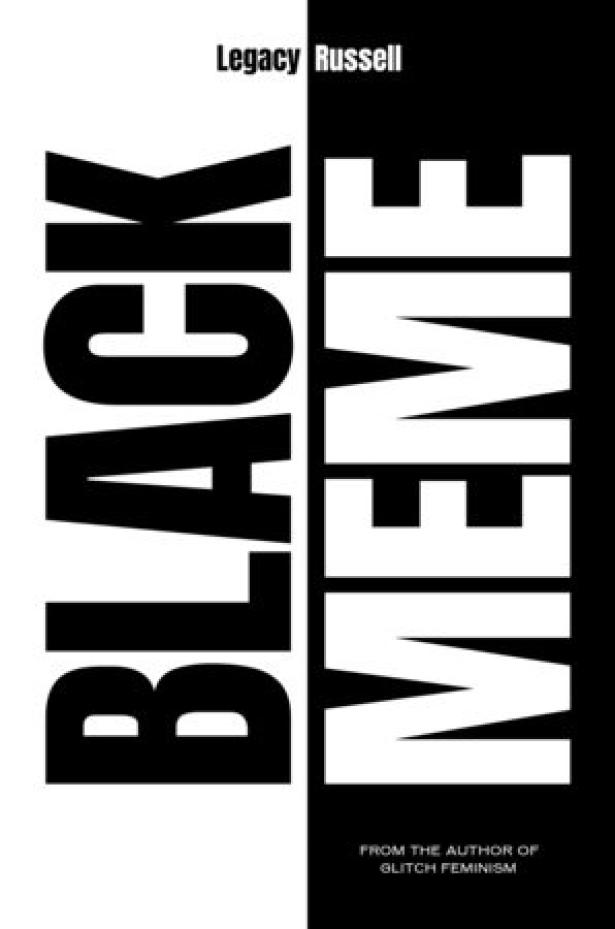Black Meme
A History of The Images That Make Us
Legacy Russell
Verso
ISBN 9781839762802
In the months preceding its release, Legacy Russell’s Black Meme: A History of the Images that Make Us (2024) generated a considerable amount of literary notoriety. The curator and writer’s second publication details the story of memetic Blackness — the migration and circulation of Blackness as material — deftly stitching together analyses of accounts from across the last century. Its endnotes read like a stark index of events that have shaped our racialized cultural consciousness: Emmett Till’s murder and trial in 1955; the Selma to Montgomery March in 1965; the 1968 Olympics Black Power Salute; the video of Los Angeles police beating Rodney King in 1991; and the murders of Philando Castile and Breonna Taylor at the hands of police in 2016 and 2020, respectively.
The book begins with a kiss: an act of Black love captured at the end of the 1913 silent film Lime Kiln Field Day — the oldest surviving film featuring Black actors. Although not unusual for this period, Russell notes that the lauded Bahamian-born actor Bert Williams dons blackface in this scene (as if his identity needed to be caricatured to be legible). She continues to breach and bend the lines of transmission from this particular piece of media, tracing its 1980s MoMA restoration, its inclusion in Garrett Bradley’s 2019 documentary, America, and its applause from film curator Ron Magliozzi, who — in a puzzling attempt to offer cultural reparation — invited Black artists to sample and remix the material, noting, “I would like it to go viral.”
Indeed, virality itself is crucial to the role of the Black meme, here defined as “the mediation, copying, and carrying of Blackness itself as a viral agent… buoyed forth by modern media.” Russell continues to cover a broad spectrum of cultural examinations, set against the backdrop of our hyper-connected late capitalist society. Of the Black reaction GIF, she writes: “ performs and circulates without permission of or payment to those depicted within them,” and “this digital material… makes the Blackness within it a caricature, a cartoon.”
The subject of the Black meme is held captive in time, as if trapped in a game of charades it will never win. This, Russell theorizes, turns a trope into a trap, creating a set of relations that dehumanize and alienate the Black body, turning it into a symbol or token that can be endlessly exchanged as capital. Citing civil liberties scholar Cheryl I. Harris, Russell makes the compelling case that because notions of property are dependent on transferability, the possibility of owning, replicating, and remediating Black material — from Michael Jackson’s “Thriller” (1982) to Jalaiah Harmon’s viral #RenegadeDance — constitutes a theft rooted in historical frameworks of subordination.
Mapping contemporary and archival media alike, Russell exposes the double-edged blade of engaging with Blackness as symbol. Whether derogatory or honorific, the image of Black identity is often instrumentalized for profit, while the validity or value of that same identity is systemically invalidated or rejected. There is often a desire to participate in the cultural caché of Blackness without the burden that Black identity carries in such a prejudiced society. Russell quotes writer Doreen St. Felix, who summarizes: “Everyone want to be a black woman but nobody want to be a black woman.”
In her outro, she concludes, “Let us demand that Blackness — and its transmission — be recognized as something more than an aesthetic event.” She warns that “the internet is now the largest institution of visual culture on earth,” and argues that we must restructure authorship in relation to the digital if we are to address these economies of injustice and unpaid labor online.
While offering little in the way of programmatic resolution, Russell’s logic enters these unmentionable territories so that we might listen, read, and respond — because how might we approach new tactics if we have not yet admitted that these events, sensations, and memories are, in fact, real violence? Ignoring them, she suggests, is an even deeper violence. If we fail to recognize — and therefore, remain complicit in the stifling patterns of silences, surveillance, and glamorized trauma — how do we begin to change the cultural narrative? Russell calls for a shift in the theorization of the Black meme, reorienting our attention so that we might disrupt the present-day subjugation that drives our constant misrecognition of Black cultural expression.
Eileen Isagon Skyers is an artist, writer, and curator whose practice and criticism are focused on digital art and culture. Born in Manila, Philippines, she is currently based in New York City. She has worked with contemporary art and nonprofit arts organizations including the Whitney Museum, David Zwirner, Frame Contemporary Art Finland, and PICA. Her first book, Vanishing Acts, was published by LINK Editions.


Spread the word